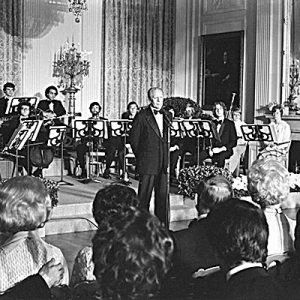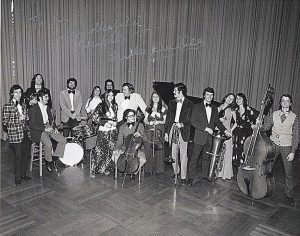The Bach Dancing & Dynamite Society’s Chamber Music Festival: Celebrating Ragtime to Jazz

Above Left: New England Ragtime Ensemble performed in tghe White House duriong President Gerald Ford’s administration in the mid-1970s during the Ragtime Revival.

Above: Members of New England Ragtime Ensemble, many of whom will be performing as a part of the Bach Dancing & Dynamite Society’s Chamber Music Festival. Stephanie Jutt is second from the right and Gunther Schuller stands to the left of the piano in a white suit and bow tie.
By Jonathan Gramling
While ragtime was born in the late 1890s out of the Black experience, most people know of it today due to the ragtime revival that occurred in the 1970s propelled by people such as Gunther Schuller and The Entertainer — published in 1902 — from the movie soundtrack of The Sting starring Paul Newman and Robert Redford.
But while ragtime did become a big part of American culture and in turn served as the roots for early jazz, ragtime was big in the Black community even before it was known as ragtime.
According to Wikipedia, “In a 1913 interview published in the Black newspaper New York Age, Scott Joplin asserted that there had been "ragtime music in America ever since the Negro race has been here, but the white people took no notice of it until about twenty years ago [in the 1890s]."
Joplin, of course, was the most prolific and well-known ragtime piano players of that era. Stephanie Jutt was a student in the 1970s at the New England Conservatory where Schuller was president, got caught up in the ragtime revival because Schuller was one of the forces behind the revival and performed in the New England Conservatory Ragtime Ensemble.
“Gunther Schuller was also a very important author and enthusiast of early jazz,” Jutt said. “Gunther wrote a book called Early Jazz in 1968, which is still considered the source of information about the development of jazz in the United States. And he had one of the most important record collections of the early recordings of people like Jelly Roll Morton. Gunther had this incredible collection of early jazz records, which were willed to the Smithsonian Institution. He had one of the most important collections of these kinds of recordings, even going back to cylinder recordings. He was the person who kind of rediscovered Scott Joplin’s Red Back Book. And the first CD that Gunther produced was for Angel Records was called The Red Back Book. It won a Grammy in 1974. He was really the person responsible for the ragtime craze or the revival of ragtime in the late 1970s into the 1980s. And our group toured all across the Soviet Union, throughout Europe and all over the United States playing ragtime and early jazz. Gunther died a few years ago in Boston. And we all got together again for a special, commemorative concert in his honor on his birthday a couple of years ago.”
While ragtime began on the fringe of American society, by the end of its first time around, it had a heavy influence on mainstream music.
“The term ragtime kind of refers to a syncopated rhythm,” Jutt said. “And back during that time, they called that ragging the rhythm. That was the term that was used for making this style of syncopation in primarily piano players. Ragtime and early jazz, those sounds, crept into a lot of what became the American vernacular in music. It kind of used the form of a Souza march to provide the structure of a ragtime piece. It was often played by pianists who worked in brothels. And it was not really presented as concert hall music in the beginning. But then around 1910, it became so popular in America; I think The Maple Leaf Rag was the first million seller of sheet music in the U.S. Everyone wanted to try and play this piece. They created arrangements for what they called Palm Court Orchestras that played in fancy hotels like the Ritz Carleton. And these Palm Court Orchestras had many arrangements made for them of ragtime pieces.”
While the group hadn’t performed together for several decades, they found that they still loved performing themusic. As the producer of the Bach Dancing & Dynamite Society’s Chamber Music Festival each year, Jutt had the platform for the group to get together once more. The reunion was delayed for several years, but The New England Ragtime Ensemble will bring a taste of ragtime to Madison this month.
“During the weekend, during the festival, The New England Ragtime Ensemble is going to be performing at the Stoughton Opera House on Saturday night at 7:30 p.m. on June 25th and on Sunday at 2:30 p.m. in the new Hamel Music Center on the UW- campus,” Jutt said. “A lot of the players performed together in the group when we were still students at New England Conservatory. Most of these people are going to be here in Madison because most of us are still playing professionally. It’s a really amazing group.”
The ensemble will be doing more than just playing ragtime, they will also be giving people an understanding of what ragtime is all about.
“We’re going to be talking a little bit about the history of ragtime during our concerts as well,” Jutt said. “An early form of ragtime was the Cake Walk originating in the Black community. This was an actual dance that was performed probably by people of African origins who were raffling off a cake. You can see on YouTube examples of the Cake Walk. And so one of the pieces we are playing, for example, is by Claude Debussy called Golliwog’s Cake Walk. It’s a French composer’s take on a ragtime piece. There was a ragtime festival for many, many years in Sedalia, Missouri. We played that. We are really trying to show the breadth of ragtime and how it evolved in the United States and how it became useful for composers to write what they called ‘novelty pieces,’ which include Kitten on the Keys and Dizzy Fingers. They were insanely popular in America. People would buy the sheet music — they couldn’t play it — and put it on their piano. We’re going to be playing Gunther’s arrangements of Dizzy Fingers and Kitten on the Keys in our performances.”
And the performance will reflect the evolution of ragtime over the decades.
“We’re going to be doing some of the earliest rags, one by Tom Turpin called The Harlem Rags from 1898 or something like that,” Jutt said. “A lot of them were written around the turn of the century. But they go on and on and on. And we’re playing some rags that were written by composers who are still alive today. And one of those that we will be playing is by a member of our ensemble, another is by a New York composer, and Gunther Schuller himself wrote one. The style is really beautiful to work with. What I call a classical ragtime piece is kind of modeled after a John Phillip Souza march. In these classical ragtime pieces like The Maple Leaf Rag and many others, they have several themes, an A theme, B theme and C theme. For every one of these ragtime pieces, the composer had to come up with three really beautiful melodies, which they did. And Scott Joplin, of course, is one of the most prolific. He is by no means the only composer. There are many others.”
As the Roaring Twenties dawned in America, ragtime evolved into jazz. “Ragtime impacted jazz in the early 1920s,” Jutt said. “As soon as Tin Pan Alley became very big and all of these many, many songwriters and composers congregated in New York City writing popular music for all different kinds of occasions, maybe film and all possible uses, ragtime became something that was a part of the American musical language. It is well illustrated through a piece composed by Jelly Roll Morton and performed by The Hot Five.” While Jutt is retired from UW-Madison, she almost sounds like that young college student once again due to the enthusiasm and passion that she has for ragtime. She gives homage to ragtime’s African American roots and is almost an ambassador for the art form.
“It’s pretty wonderful stuff and it is a lot more sophisticated maybe than people know about, so I hope people will turn out to see these concerts,” Jutt said. “I know we are mostly white people playing this Black music, but we do have a few Black members in the group. And we all went to the conservatory together. We have loved this music for a long time and we hope that people will turn out to hear it.”
And so for enthusiastic renditions of some of that old ragtime music, come on out to the New England Ragtime Ensemble performances. For more information and to buy tickets, visit www.bachdancing.org.



